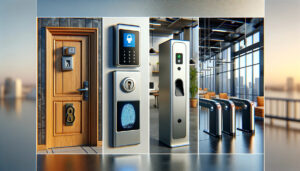Introduction
Access control systems are pivotal in safeguarding people, property, and data. These systems restrict entry to authorized individuals, thus playing a critical role in enhancing security. From simple mechanical locks to sophisticated biometric systems, access control technologies have evolved to meet diverse security needs. This blog post aims to offer a comprehensive overview of the various types of access control systems, detailing their applications, advantages, and disadvantages to help you understand which system best suits your needs.
Physical Access Control Systems
Definition and Applications
Physical access control is a security technique that manages who can or cannot access a physical space. It is commonly used in buildings, rooms, or other physical assets to protect people and property.
Types of Physical Access Control Systems
- Mechanical: This includes traditional key locks, deadbolts, and padlocks. They are simple, cost-effective, and widely used for basic security needs.
- Electronic: Systems like keycard readers, keypad entry systems, and proximity readers offer more security than mechanical locks by requiring electronic keys or codes.
- Biometric: Utilizing unique physical or behavioral characteristics, such as fingerprints, iris patterns, or facial features, biometric systems offer high security and convenience.
- Barrier Devices: Gates, turnstiles, and fences control access to premises, directing and managing the flow of people.
Each type has its advantages and disadvantages, from the simplicity and affordability of mechanical locks to the advanced security but higher cost of biometric systems.

Logical Access Control Systems
Definition and Role
Logical access control systems protect digital assets by ensuring that only authorized users can access certain data or systems. This is crucial for protecting sensitive information from unauthorized access or breaches.
Types of Logical Access Control Systems
- Password Authentication: The most basic form, involving usernames and passwords to verify identity.
- Multi-factor Authentication (MFA): Adds layers of security by combining passwords with other verification factors, such as biometric data or one-time codes.
- Role-based Access Control (RBAC): Access is granted based on the user's role within an organization, streamlining the permissions management process.
- Attribute-based Access Control (ABAC): Decisions are made based on attributes (location, device, time), offering flexibility and granularity in access control.
Each method has its strengths and weaknesses, balancing security with usability and cost.

Hybrid Access Control Systems
Definition & Role
Hybrid access control systems are an innovative fusion of physical and logical security measures designed to provide an all-encompassing safeguarding solution. These systems are crafted to ensure the integrity of both physical spaces and digital information, making them ideal for environments where the protection of tangible assets and sensitive data is equally crucial. The role of hybrid systems is to offer a seamless security experience, mitigating risks from both unauthorized physical entry and cyber threats, thereby establishing a secure and resilient operational environment.
Types of Hybrid Access Control Systems
Hybrid systems can be categorized based on their integration level and the technologies they employ:
- Integrated Systems: These systems offer a unified platform that combines physical access control, such as biometric entry systems, with logical security measures like network access controls. This integration allows for centralized management of both physical and digital accesses.
- Converged Systems: Converged solutions take integration a step further by not only combining physical and logical access controls but also incorporating additional security layers such as surveillance and alarm systems. This convergence ensures a comprehensive security posture that addresses a wide array of threats.
- Intelligent Systems: Leveraging advanced technologies such as AI and machine learning, intelligent hybrid systems can predict and mitigate security risks by analyzing patterns and behaviors. These systems adapt over time, offering dynamic protection strategies that evolve with the threat landscape.

Choosing the Right Access Control System
Choosing the right access control system for your organization involves a detailed and methodical approach to ensure that the selected system aligns with your security requirements, budgetary constraints, and operational needs. Here's how to break down the process into actionable steps:
Step 1: Conduct a Security Needs Assessment
- Objective: Identify and prioritize the security challenges and requirements of your organization.
- Details: Start by mapping out the physical and digital assets that require protection. Assess the potential risks and threats to these assets to understand the level of security needed. Consider both external and internal threats, and prioritize them based on their impact and likelihood.
Step 2: Evaluate Budgetary Constraints
- Objective: Determine the financial resources available for implementing an access control system.
- Details: Review your organization's budget to identify the amount allocated for security improvements. This will help narrow down the options to those that are financially feasible. Remember to account for not just the initial installation costs but also ongoing maintenance and potential future upgrades.
Step 3: Understand the User Base
- Objective: Analyze the demographic characteristics of the individuals who will interact with the access control system.
- Details: Consider the size of the user base, their technological proficiency, and their specific access needs. This step is crucial for ensuring user compliance and the smooth operation of the system. A system that is too complex for the intended users may lead to security breaches due to non-compliance or misuse.
Step 4: Assess System Complexity and Integration Capabilities
- Objective: Evaluate the complexity of the access control systems and their ability to integrate with existing systems.
- Details: Consider how the new access control system will fit into your current security infrastructure. Assess whether it can integrate with existing security measures, such as surveillance systems, and whether it supports scalability to accommodate future growth. The goal is to ensure a seamless security ecosystem that can evolve with your organization's needs.
Step 5: Weigh the Pros and Cons of Each System
- Objective: Compare different access control systems to understand their advantages and disadvantages.
- Details: Analyze the features, reliability, ease of use, and the level of security each system offers. Consider the potential drawbacks, such as vulnerabilities or limitations in functionality. This step involves a detailed comparison to identify the system that best matches your prioritized security needs and constraints.
Step 6: Make an Informed Decision
- Objective: Choose the access control system that best fits your organization's specific needs, budget, and operational demands.
- Details: Based on the insights gathered from the previous steps, select the system that provides the optimal balance of security, affordability, user-friendliness, and integration capabilities. Ensure that the decision-making process is inclusive, involving key stakeholders from security, IT, and executive teams to garner broad support and buy-in.
By following these steps, organizations can navigate the complex process of selecting an access control system, ultimately securing a solution that is tailored to their unique security landscape and operational requirements.
Conclusion
This blog post has explored the various types of access control systems, including physical, logical, and hybrid models. Each system has unique features designed to meet different security needs. The importance of selecting the right access control system cannot be overstated, as it is fundamental to protecting people, property, and data. We encourage readers to delve deeper into these systems and seek professional advice to ensure optimal security solutions for their specific needs. Call us at +1 949-333-1000 for more information.
FAQs
FAQ 1: Can Access Control Systems be Upgraded or Expanded Over Time?
Answer: Yes, many access control systems are designed with scalability in mind, allowing for upgrades or expansions as your organization grows or as technology advances. When selecting a system, it's important to consider future needs and ensure the system can adapt to new security technologies, additional users, or expanded physical spaces.
FAQ 2: How Do Access Control Systems Enhance Compliance with Data Protection Regulations?
Answer: Access control systems play a crucial role in ensuring compliance with data protection regulations by controlling who has access to sensitive information. By implementing role-based or attribute-based access controls, organizations can enforce the principle of least privilege, ensuring individuals have access only to the data necessary for their role, thereby aiding in compliance with regulations like GDPR or HIPAA.
FAQ 3: What Are the Considerations for Remote Access Management in Access Control Systems?
Answer: When incorporating remote access management, consider the security of the connections (e.g., VPNs), the authentication methods (such as multi-factor authentication), and the ability to monitor and manage access rights remotely. It's also vital to ensure remote access solutions comply with your organization's security policies and industry best practices to mitigate potential cybersecurity risks.


You must be logged in to post a comment.